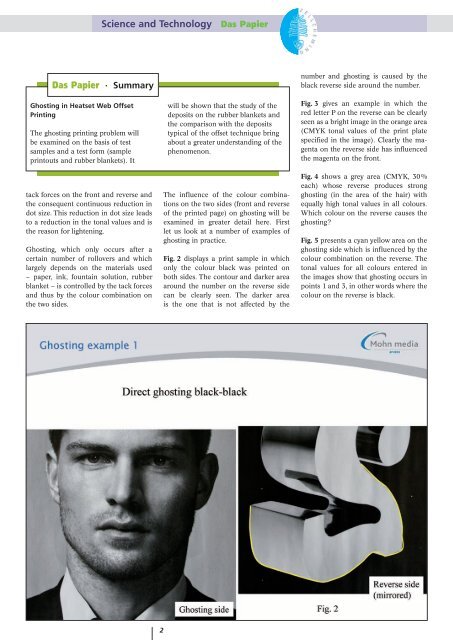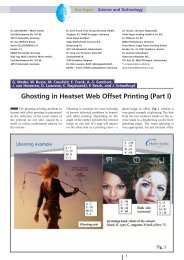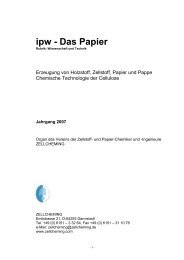Ghosting in Heatset Web Offset Printing (Part II) - Zellcheming
Ghosting in Heatset Web Offset Printing (Part II) - Zellcheming
Ghosting in Heatset Web Offset Printing (Part II) - Zellcheming
You also want an ePaper? Increase the reach of your titles
YUMPU automatically turns print PDFs into web optimized ePapers that Google loves.
6/2008 Science and Technology Das Papier<br />
Das Papier · Summary<br />
<strong>Ghost<strong>in</strong>g</strong> <strong>in</strong> <strong>Heatset</strong> <strong>Web</strong> <strong>Offset</strong><br />
Pr<strong>in</strong>t<strong>in</strong>g<br />
The ghost<strong>in</strong>g pr<strong>in</strong>t<strong>in</strong>g problem will<br />
be exam<strong>in</strong>ed on the basis of test<br />
samples and a test form (sample<br />
pr<strong>in</strong>touts and rubber blankets). It<br />
tack forces on the front and reverse and<br />
the consequent cont<strong>in</strong>uous reduction <strong>in</strong><br />
dot size. This reduction <strong>in</strong> dot size leads<br />
to a reduction <strong>in</strong> the tonal values and is<br />
the reason for lighten<strong>in</strong>g.<br />
<strong>Ghost<strong>in</strong>g</strong>, which only occurs after a<br />
certa<strong>in</strong> number of rollovers and which<br />
largely depends on the materials used<br />
– paper, <strong>in</strong>k, founta<strong>in</strong> solution, rubber<br />
blanket – is controlled by the tack forces<br />
and thus by the colour comb<strong>in</strong>ation on<br />
the two sides.<br />
Das Papier 2008–T57<br />
will be shown that the study of the<br />
deposits on the rubber blankets and<br />
the comparison with the deposits<br />
typical of the offset technique br<strong>in</strong>g<br />
about a greater understand<strong>in</strong>g of the<br />
phenomenon.<br />
The <strong>in</strong>fluence of the colour comb<strong>in</strong>ations<br />
on the two sides (front and reverse<br />
of the pr<strong>in</strong>ted page) on ghost<strong>in</strong>g will be<br />
exam<strong>in</strong>ed <strong>in</strong> greater detail here. First<br />
let us look at a number of examples of<br />
ghost<strong>in</strong>g <strong>in</strong> practice.<br />
Fig. 2 displays a pr<strong>in</strong>t sample <strong>in</strong> which<br />
only the colour black was pr<strong>in</strong>ted on<br />
both sides. The contour and darker area<br />
around the number on the reverse side<br />
can be clearly seen. The darker area<br />
is the one that is not affected by the<br />
2 www.ipwonl<strong>in</strong>e.de<br />
number and ghost<strong>in</strong>g is caused by the<br />
black reverse side around the number.<br />
Fig. 3 gives an example <strong>in</strong> which the<br />
red letter P on the reverse can be clearly<br />
seen as a bright image <strong>in</strong> the orange area<br />
(CMYK tonal values of the pr<strong>in</strong>t plate<br />
specified <strong>in</strong> the image). Clearly the magenta<br />
on the reverse side has <strong>in</strong>fluenced<br />
the magenta on the front.<br />
Fig. 4 shows a grey area (CMYK, 30 %<br />
each) whose reverse produces strong<br />
ghost<strong>in</strong>g (<strong>in</strong> the area of the hair) with<br />
equally high tonal values <strong>in</strong> all colours.<br />
Which colour on the reverse causes the<br />
ghost<strong>in</strong>g?<br />
Fig. 5 presents a cyan yellow area on the<br />
ghost<strong>in</strong>g side which is <strong>in</strong>fluenced by the<br />
colour comb<strong>in</strong>ation on the reverse. The<br />
tonal values for all colours entered <strong>in</strong><br />
the images show that ghost<strong>in</strong>g occurs <strong>in</strong><br />
po<strong>in</strong>ts 1 and 3, <strong>in</strong> other words where the<br />
colour on the reverse is black.





